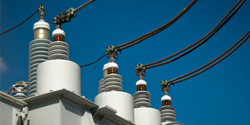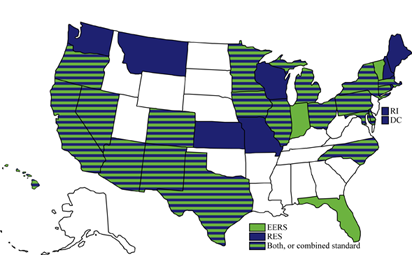Clean Energy Standards

Clean Energy Standards
A program to foster innovation and job creation, improve
energy security, and cut pollution in the electricity sector
Clean Energy Standard Overview
A Clean Energy Standard (CES) is a flexible mechanism to ensure utilities meet an increasing percentage of their electricity sales using clean sources. These sources may include renewable, nuclear, natural gas, and coal with carbon capture and sequestration (CCS). Some versions may include other sources and some allow energy efficiency to count towards a portion of the requirement. A CES is similar to a renewable electricity standard (RES), which requires a certain percentage of generation to be from renewable sources. It may also be similar to an Energy Efficiency Resource Standard (EERS), which requires that a percentage of projected use be mitigated with energy efficiency programs. EERS and RES programs are tested policy measures that have successfully reduced energy use and increased renewable power generation in many states. A nation-wide CES could foster high-technology innovation while reducing air pollution and global warming.
States With EERS and RES Programs
EERS states include those whose RES regulations allow efficiency in some manner. Washington State requires “all cost-effective conservation.” Those with voluntary EERS or RES programs are not included.* |
CES Proposals
In January 2011, the Obama Administration proposed a Federal clean energy standard as part of a broad program of energy innovation and job creation. The Administration proposal would double the amount of clean energy in domestic generation. According to the Obama Administration, 40 percent of domestic electricity presently comes from sources it categorizes as clean energy, so under this proposal energy from renewables, nuclear, natural gas, and coal with CCS would represent 80 percent of domestic electricity supplies by 2035. Natural gas and coal with CCS would earn a reduced credit amount as compared to renewable and nuclear power. While it is not yet clear what role energy efficiency would directly play for utilities to meet CES requirements, inclusion of energy efficiency could keep costs down while furthering the goals of the program.
The Administration proposes supporting the goals of the CES through complementary programs such as increased clean energy research and development through the Advanced Research Projects Agency—Energy (ARPA-E) and Energy Innovation Hubs, among other efficiency and renewable programs.
In order to mitigate any effects on consumer electricity bills, the CES would be coupled with other programs to encourage energy efficiency, including stronger appliance efficiency standards, tax credits for energy efficiency upgrades, and passage of the Home Star program for energy efficiency rebates and financing. Support for manufacturers’ energy efficiency could also be supported.
Clean energy targets proposed in the Clean Energy Act of 2009 | |
Calendar year | Minimum annual percentage, new clean energy |
2012 through 2014 | 13 |
2015 through 2019 | 15 |
2020 through 2024 | 20 |
2025 through 2029 | 25 |
2030 through 2034 | 30 |
2035 through 2039 | 35 |
2040 through 2044 | 40 |
2045 through 2049 | 45 |
2050 | 50 |
In the 111th Congress, a draft bill from Senator Lindsey Graham (R-S.C.), the Clean Energy Act of 2009, would have created a Federal clean energy standard for renewables, advanced coal with CCS, nuclear, and certain other sources. It could allow up to 25% of the requirement to be met with energy efficiency programs operated by a utility or by improving the efficiency of generation facilities. Credit would also be offered for the retirement of older coal-powered generators. A program of credit trading would allow those exceeding compliance levels to sell credits to those falling short of the requirements or for whom such requirements were cost prohibitive. Senator Lugar’s (R-Ind.) Practical Energy and Climate Plan of 2010 (S. 3464 in the 111th Congress) included a Diverse Energy Standard structured much like Graham’s proposal.
Efficiency Within a CES
The Graham and Lugar bills offered an example of how energy efficiency could be incorporated into a clean energy standard, viz. a portion of the annual percentage could be met with energy efficiency, subject to certain conditions. Including energy efficiency directly in this manner would ensure that cost-effective energy efficiency would be encouraged. Since energy efficiency tends to offer lower per-kilowatt-hour costs than many generation-side resources, this could reduce the cost of the program to consumers.
However, even without such a direct inclusion, a CES could provide an indirect driver for efficiency. A reduction in demand resulting from energy efficiency measures would reduce the absolute quantity of electricity that would need to be sourced from new qualifying generation. Alternately, it could allow for the retirement of non-clean energy sources. This later option could provide additional benefit in programs structured like Senator Graham’s proposal, which offered credit for the retirement of inefficient older coal generation facilities.
February 2011
* Adapted from FERC, “Other Markets: Renewables & Energy Efficiency - Generation & Efficiency Standards.”
STAY EMPOWERED
Help the Alliance advocate for policies to use energy more efficiently – supporting job creation, reduced emissions, and lower costs. Contact your member of Congress.
Energy efficiency is smart, nonpartisan, and practical. So are we. Our strength comes from an unparalleled group of Alliance Associates working collaboratively under the Alliance umbrella to pave the way for energy efficiency gains.
The power of efficiency is in your hands. Supporting the Alliance means supporting a vision for using energy more productively to achieve economic growth, a cleaner environment, and greater energy security, affordability, and reliability.




